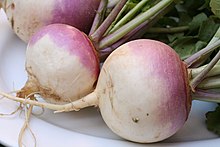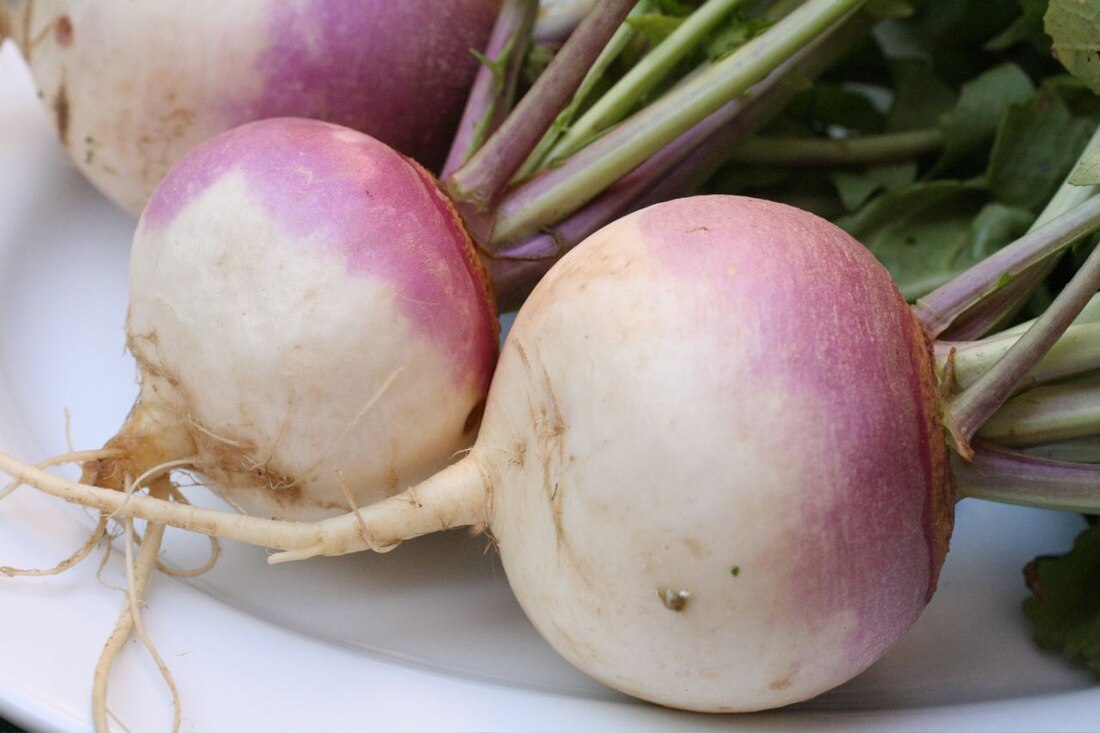The turnip or white turnip (Brassica rapa subsp. rapa) is a root vegetable commonly grown in temperate climates worldwide for its white, fleshy taproot. Small, tender varieties are grown for human consumption, while larger varieties are grown as feed for livestock. The name turnip – used in many regions – may also include rutabaga, neep or swede.[1]
| Turnip | |
|---|---|
 | |
| Turnip roots | |
| Scientific classification | |
| Kingdom: | Plantae |
| Clade: | Tracheophytes |
| Clade: | Angiosperms |
| Clade: | Eudicots |
| Clade: | Rosids |
| Order: | Brassicales |
| Family: | Brassicaceae |
| Genus: | Brassica |
| Species: | |
| Variety: | B. r. var. rapa |
| Trinomial name | |
| Brassica rapa var. rapa | |
Etymology
The origin of the word turnip is uncertain, though it is hypothesised that it could be a compound of turn as in turned/rounded on a lathe and neep, derived from Latin napus, the word for the plant. According to An Universal Etymological English Dictionary, turn refers to "round napus to distinguish it from the napi, which were generally long".[2]
Description

The most common type of turnip is mostly white-skinned apart from the upper 1 to 6 centimetres (1⁄2 to 2+1⁄2 inches), which protrude above the ground and are purple or red or greenish where the sun has hit. This above-ground part develops from stem tissue, but is fused with the root.[citation needed] The interior flesh is entirely white. The root is roughly globular, from 5–20 cm (2–8 in) in diameter, and lacks side roots. Underneath, the taproot (the normal root below the swollen storage root) is thin and 10 cm (4 in) or more in length; it is often trimmed off before the vegetable is sold. The leaves grow directly from the above-ground shoulder of the root, with little or no visible crown or neck (as found in rutabagas).[citation needed]
Turnip leaves are sometimes eaten as "turnip greens" ("turnip tops" in the UK), and they resemble mustard greens (to which they are closely related) in flavor. Turnip greens are a common side dish in southeastern U.S. cooking, primarily during late Fall and Winter. Smaller leaves are preferred. Varieties of turnip grown specifically for their leaves resemble mustard greens and have small roots. These include rapini (broccoli rabe), bok choy, and Chinese cabbage. Similar to raw cabbage or radish, turnip leaves and roots have a pungent flavor that becomes milder after cooking.[citation needed]
Turnip roots weigh up to 1 kilogram (2 pounds 3 ounces), although they are usually harvested when smaller. Size is partly a function of variety and partly a function of the length of time the turnip has grown.
Nutrition
| Nutritional value per 100 g (3.5 oz) | |||||||||||||||||||||||||||||||||||||||||||||||
|---|---|---|---|---|---|---|---|---|---|---|---|---|---|---|---|---|---|---|---|---|---|---|---|---|---|---|---|---|---|---|---|---|---|---|---|---|---|---|---|---|---|---|---|---|---|---|---|
| Energy | 84 kJ (20 kcal) | ||||||||||||||||||||||||||||||||||||||||||||||
4.4 g | |||||||||||||||||||||||||||||||||||||||||||||||
| Sugars | 0.5 g | ||||||||||||||||||||||||||||||||||||||||||||||
| Dietary fiber | 3.5 g | ||||||||||||||||||||||||||||||||||||||||||||||
0.2 g | |||||||||||||||||||||||||||||||||||||||||||||||
1.1 g | |||||||||||||||||||||||||||||||||||||||||||||||
| |||||||||||||||||||||||||||||||||||||||||||||||
| Other constituents | Quantity | ||||||||||||||||||||||||||||||||||||||||||||||
| Water | 93.2 g | ||||||||||||||||||||||||||||||||||||||||||||||
| Lutein | 8440 µg | ||||||||||||||||||||||||||||||||||||||||||||||
| †Percentages estimated using US recommendations for adults,[3] except for potassium, which is estimated based on expert recommendation from the National Academies.[4] | |||||||||||||||||||||||||||||||||||||||||||||||
| Nutritional value per 100 g (3.5 oz) | |||||||||||||||||||||||||||||||||||||||||||
|---|---|---|---|---|---|---|---|---|---|---|---|---|---|---|---|---|---|---|---|---|---|---|---|---|---|---|---|---|---|---|---|---|---|---|---|---|---|---|---|---|---|---|---|
| Energy | 92 kJ (22 kcal) | ||||||||||||||||||||||||||||||||||||||||||
5.1 g | |||||||||||||||||||||||||||||||||||||||||||
| Sugars | 3.0 | ||||||||||||||||||||||||||||||||||||||||||
| Dietary fiber | 2.0 g | ||||||||||||||||||||||||||||||||||||||||||
0.1 g | |||||||||||||||||||||||||||||||||||||||||||
0.7 g | |||||||||||||||||||||||||||||||||||||||||||
| |||||||||||||||||||||||||||||||||||||||||||
| Other constituents | Quantity | ||||||||||||||||||||||||||||||||||||||||||
| Water | 93.6 g | ||||||||||||||||||||||||||||||||||||||||||
| †Percentages estimated using US recommendations for adults,[3] except for potassium, which is estimated based on expert recommendation from the National Academies.[4] | |||||||||||||||||||||||||||||||||||||||||||
Boiled green leaves of the turnip top ("turnip greens") provide 84 kilojoules (20 kilocalories) of food energy in a reference serving of 100 grams (3+1⁄2 oz), and are 93% water, 4% carbohydrates, and 1% protein, with negligible fat (table). The boiled greens are a rich source (more than 20% of the Daily Value, DV) particularly of vitamin K (350% DV), with vitamin A, vitamin C, and folate also in significant content (30% DV or greater, table). Boiled turnip greens also contain substantial lutein (8440 micrograms per 100 g).
In a 100-gram reference amount, boiled turnip root supplies 92 kJ (22 kcal), with only vitamin C in a moderate amount (14% DV). Other micronutrients in boiled turnip are in low or negligible content (table). Boiled turnip is 94% water, 5% carbohydrates, and 1% protein, with negligible fat.
History
Wild forms of the turnip and its relatives, the mustards and radishes, are found over western Asia and Europe. Starting as early as 2000 BCE, related oilseed subspecies of Brassica rapa like oleifera may have been domesticated several times from the Mediterranean to India, though these are not the same turnips cultivated for its roots.[5] Previous estimates of domestication dates are limited to linguistic analyses of plant names.[6]
Edible turnips were first domesticated in Central Asia several thousand years ago, supported by genetic studies of both wild and domesticated varieties showing Central Asian varieties are the most genetically diverse crops.[7] Ancient literary references to turnips in Central Asia, and the existence of words for 'turnip' in ancestral languages of the region, also support the turnip as the original domesticated form of Brassica rapa subsp. rapa.[7] It later spread to Europe and East Asia with farmers in both areas later selecting for larger leaves; it subsequently became an important food in the Hellenistic and Roman world.[5] The turnip spread to China, and reached Japan by 700 CE.[5]
Turnips were an important crop in the cuisine of Antebellum America. They were grown for their greens as well as the roots, and could yield edible greens within a few weeks of planting, making them a staple of new plantations still in the process of becoming productive. They could be planted as late as the fall and still provide newly arrived settlers with a source of food. The typical southern way of cooking turnip greens was to boil them with a chunk of salt pork. The broth obtained from this process was known as pot likker and was served with crumbled corn pone, often made from coarse meal when little else was available along the antebellum frontier.[8]
Cultivation
The 1881 American Household Cyclopedia advises that turnips can be grown in fields that have been harrowed and ploughed. It recommends planting in late May or June and weeding and thinning with a hoe throughout the summer.[9]
As a root crop, turnips grow best in cool weather; hot temperatures cause the roots to become woody and bad-tasting. They are typically planted in the spring in cold-weather climates (such as the northern US and Canada) where the growing season is only 3–4 months. In temperate climates (ones with a growing season of 5–6 months), turnips may also be planted in late summer for a second fall crop. In warm-weather climates (7 or more month growing season), they are planted in the fall. 55–60 days is the average time from planting to harvest.[citation needed]
Turnips are a biennial plant, taking two years from germination to reproduction. The root spends the first year growing and storing nutrients, and the second year flowers, produces seeds, and dies. The flowers of the turnip are tall and yellow, with the seeds forming in pea-like pods. In areas with less than seven-month growing seasons, temperatures are too cold for the roots to survive the winter. To produce seeds, pulling the turnips and storing them over winter is necessary, taking care not to damage the leaves. During the spring, they may be set back in the ground to complete their lifecycle.[10]: 98
- Turnip (flower)
- A bundle of Tokyo turnips
Relevance in human use
In England around 1700, Charles "Turnip" Townshend promoted the use of turnips in a four-year crop-rotation system that enabled year-round livestock feeding.[11] In the United States, the smaller white vegetables are called turnips, while the larger yellow ones are referred to as rutabagas, a borrowing from Swedish rotabagge (a dialectal word from Västergötland). In most of England, turnips are the same, while the larger yellow ones are referred to as swedes. In Scotland, the larger yellow vegetables are referred to as turnips.
In the Austrian region of Wildschönau farmers produce a kind of schnaps called Krautinger from a variation of Brassica rapa ssp. Rapa, since they were granted permission to do so under Empress Maria Theresia in the 18th century.[12] It is notorious for its distinct taste and smell.
Heraldry

The turnip is an old vegetable charge in heraldry. It was used by Leonhard von Keutschach, prince-archbishop of Salzburg. The turnip is still the heart shield in the arms of Keutschach am See.[13]
The arms of the former municipality of Kiikala, Finland, were Gules, a turnip Or.[14]
References
External links
Wikiwand in your browser!
Seamless Wikipedia browsing. On steroids.
Every time you click a link to Wikipedia, Wiktionary or Wikiquote in your browser's search results, it will show the modern Wikiwand interface.
Wikiwand extension is a five stars, simple, with minimum permission required to keep your browsing private, safe and transparent.


